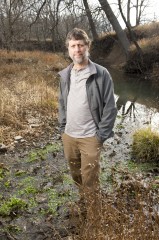Water Research Tackles Growing Grassland Threat: Trees

Kansas State University Walter Dodds, university distinguished professor of biology (pictured), and Allison Veach, doctoral student in biology, are researching grassland streams and the expansion of nearby woody vegetation. They have studied 25 years of data on the Konza Prairie Biological Station and found that increasing fire frequency reduces the rate of woody vegetation expansion.
By looking at 25 years of data on the Konza Prairie Biological Station, Allison Veach, doctoral student in biology, Muncie, Indiana, and Walter Dodds, university distinguished professor of biology, are researching grassland streams and the expansion of nearby woody vegetation, such as trees and shrubs. They have found that burn intervals may predict the rate of woody vegetation expansion along streams.
Their latest research appears in the peer-reviewed journal PLOS ONE in an article “Fire and Grazing Influences on Rates of Riparian Woody Plant Expansion along Grassland Streams.”
Grasslands in North America and across the globe are rapidly disappearing, Veach said, and woody plants are expanding and converting grasslands into forest ecosystems. This change in environment can affect stream hydrology and biogeochemistry, said Dodds, who has studied streams and watersheds on the Konza prairie for more than 20 years.
“This is an important issue regionally, because as trees expand into these grassland areas, people who are using grassland for cattle production have less grass for animals, too,” Dodds said.
In their latest research, the biologists studied 25 years of aerial photography on Konza and observed the expansion of trees and shrubs in riparian areas, which include areas within 30 meters of streambeds. The researchers focused on three factors that affect grassland streams: burn intervals; grazers, such as bison; and the historical presence of woody vegetation.
Their analysis revealed an important finding: Burn intervals predicted the rate of woody vegetation expansion. Burning every one to two years slowed the growth of trees and shrubs, Veach said.
“Although we can reduce woody expansion by burning more frequently, we can't prevent it from occurring over time,” Veach said. “Woody plant encroachment may not be prevented by fire alone.”
The research shows the importance of burning to maintain the tallgrass prairie, Dodds said. While burning can help to slow the expansion of trees and shrubs, additional actions are need to maintain quickly disappearing grassland ecosystems.
“It's clear from this research that if you don't burn at all, these grassland streams basically are going to switch to forests and will not be grassland streams anymore,” Dodds said.
Dodds and Veach also found that bison do not significantly affect woody vegetation expansion along streams. Previous Konza research has shown that bison do not spend significant time near stream areas, so they may not influence the growth of nearby trees and shrubs, Veach said.
Woody vegetation also may be expanding in grasslands because of more carbon dioxide in the atmosphere, Dodds said. Grasses and trees compete for carbon dioxide, and grasses are much better at conserving water and efficiently using carbon dioxide. As atmospheric carbon dioxide levels increase, it becomes easier for trees to gather carbon dioxide and gives them a growing advantage over grasses.
“The tallgrass prairie is almost nonexistent on the globe,” Veach said. “In order for us to preserve tallgrass prairie, we need to look at woody encroachment because it has been an issue. Things like no fire or differences in climate change may allow woody plant species to competitively take over grasslands.”
The biologists plan to continue studying water quality and quantity issues at Konza. Konza is an 8,600-acre tallgrass prairie ecological research site jointly owned by the university and The Nature Conservancy.
Veach and Dodds received research funding from the National Science Foundation's Konza Prairie Long-Term Ecological Research program and the Kansas Experimental Program to Stimulate Competitive Research. The research also involved Adam Skibbe at the University of Iowa.
Contact Information
Jennifer Torline Tidball
Science/Research writer
jtidball@k-state.edu
Phone: 785-532-0847
Mobile: 785-532-7355
Media Contact
More Information:
http://www.k-state.eduAll latest news from the category: Ecology, The Environment and Conservation
This complex theme deals primarily with interactions between organisms and the environmental factors that impact them, but to a greater extent between individual inanimate environmental factors.
innovations-report offers informative reports and articles on topics such as climate protection, landscape conservation, ecological systems, wildlife and nature parks and ecosystem efficiency and balance.
Newest articles

Bringing bio-inspired robots to life
Nebraska researcher Eric Markvicka gets NSF CAREER Award to pursue manufacture of novel materials for soft robotics and stretchable electronics. Engineers are increasingly eager to develop robots that mimic the…

Bella moths use poison to attract mates
Scientists are closer to finding out how. Pyrrolizidine alkaloids are as bitter and toxic as they are hard to pronounce. They’re produced by several different types of plants and are…

AI tool creates ‘synthetic’ images of cells
…for enhanced microscopy analysis. Observing individual cells through microscopes can reveal a range of important cell biological phenomena that frequently play a role in human diseases, but the process of…





















